BLOG | September 12, 2023
Ad Fraud: The stealthy thief of unaware victims
By David Koiffman – Marketing Manager at Winclap
A defense toolkit for your company based on real stories
The Harsh Truth
Fraud Categories
How to approach this scary situation?
A Real Story: Victim #1
Cost-efficient Solutions
Testimonial
Before we start, make sure to check fraud basics in our previous post.
The Harsh Truth
Let’s start by laying it out plainly. Mobile Ad fraud is simply a false promise of marketing value.
You might think this doesn’t happen quite often when in fact, it’s the opposite. There’s a pretty high chance you’re currently a victim.
We chose our words wisely. In fact, according to ChatGPT’s definition of “stealthy”, the term emphasizes the thief’s ability to move without being noticed, suggesting careful planning to avoid detection.
Last year, installs fraud kept poisoning budgets. Over $5.4B were exposed to fraud. Moreover, the average fraud rate on Android App Installs shot up by 46% in the second half of 2022 when compared to the first. Interestingly, Mexico leads with highest detected rates*.
Here’s a strong fact for our financial audience: Almost half of the app category budgets were at risk from fraud, pointing to weaknesses in this emerging sector.
*Source: “The state of mobile app fraud” by AppsFlyer, 2023 edition“.
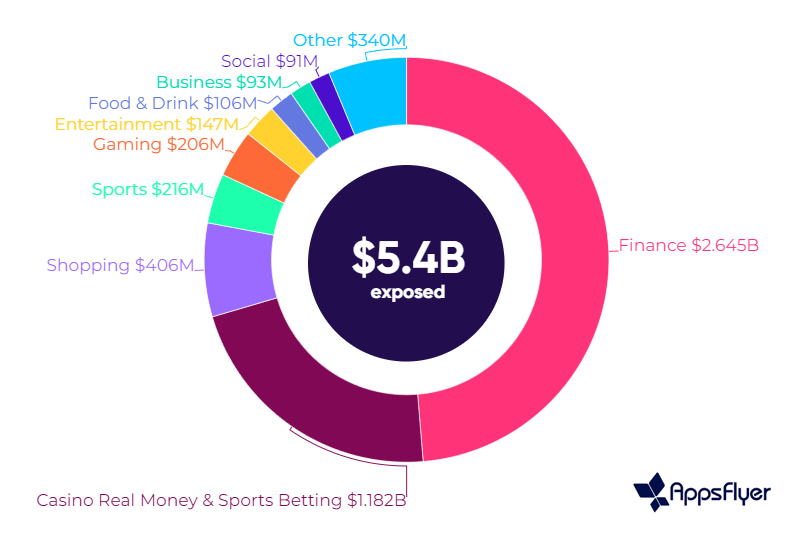
Tighter budgets boosted fraud mobile activity.
Alongside Click Flooding and Bots, fraudsters emerged in the finance sector, generating fake users instead of claiming real user’s attribution. Why did this happen? Mainly because it’s considerably easier to create fake users with a falsified device rather than fooling a real user.
 Here’s a breakdown by industry, have you found your odds yet?
Here’s a breakdown by industry, have you found your odds yet?
Wait, are there fraud categories?
Not all kinds of fraud come in the same box, you can read more about each one in our Ad Fraud article where we cover most of them, including Attribution Hijacking and Fake Users. But wow, did you know these are actual bots or device farms?
What haunts us the most is the “not knowing”. Fraud is the silent thief and victims are usually unaware of it. This harms their growth on an economic, analytical and organizational level (more on that here).
So… How should I approach this scary situation?
Listen up, this is how we tackle vicious fraud at Winclap:
First, we draft up a qualitative analysis doing transparency checks on medias to meet basic requirements. It’s not rocket science, it should be obvious, but for some reason it’s not.
Here’s also a useful mantra we keep on repeating: Assume Innocence on trustable paid channels. As for the rest, assume guilt first. Let’s deep dive and do our due diligence.
These medias present key attributes that make them highly reliable:
- Transparent reporting (impressions, clicks, placements)
- Trusted by top players in all industries
- Brand safety policies
- Consistent business models
- Trustable, but require optimization in order to deliver results!
Beware of channels that:
- Offer fixed CPA pricing
- Show abnormally low CPAs (when compared to other medias)
- Bring new users at a faster pace than Google or FB
- Have unclear optimization levers (creatives, placements, audiences, etc)
- Do not track impressions or clicks
- Do not share the site/app names where they place advertisements (brand safety issues!)
- May significantly change the trend of organic events when turned on.
A real story: Victim #1
Building awareness on the matter takes time. At Winclap, we emphasize the importance of grounding conversations in facts with our clients. Beyond the basics mentioned earlier, we diligently investigate each specific case to assess whether a company is actually paying for fraud.
Here are ten indicators of suspicious activity:
- Site IDs are not shown or unclear.
- Click-to-Install time frequency distribution does not follow a normal pattern.
- CTR > 1 (more clicks than impressions)
- Extremely low CPC/CPA (cost per click or action)
- Huge discrepancies between Media and Measurement Partner (chance of attribution theft)
- Low install-to-event ratio.
- Clicks geolocalization ≠ event geolocalization
- Organic/Paid Installs different distribution
- Huge discrepancies between Measurement Partner & Play Store console.
Let’s kick-off the investigation, shall we?
1. Unclear Site IDs
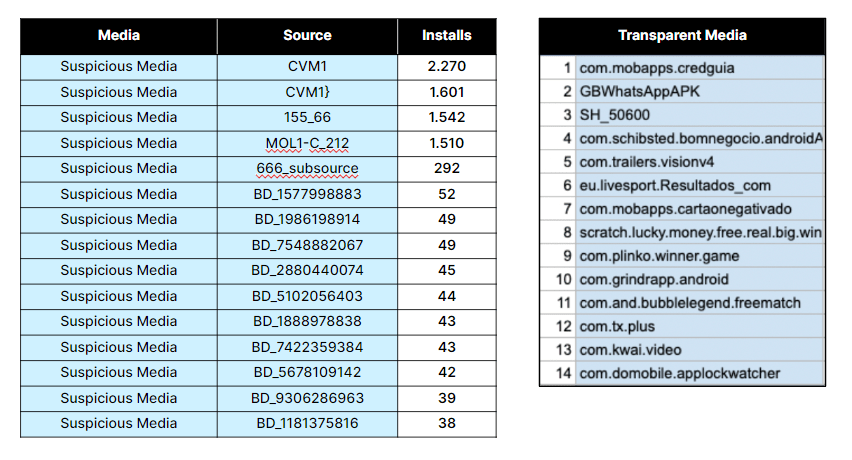
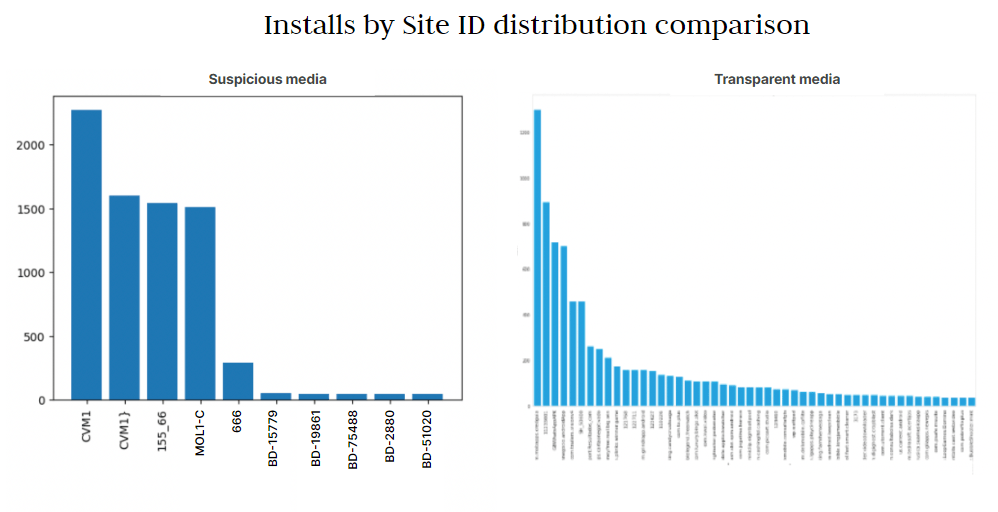 Also, when compared to a transparent media, the suspect shows almost all installs are attributed to the first 5 sites instead of a more “reasonable” distribution.
Also, when compared to a transparent media, the suspect shows almost all installs are attributed to the first 5 sites instead of a more “reasonable” distribution.
2. Click-to-Install time frequency distribution
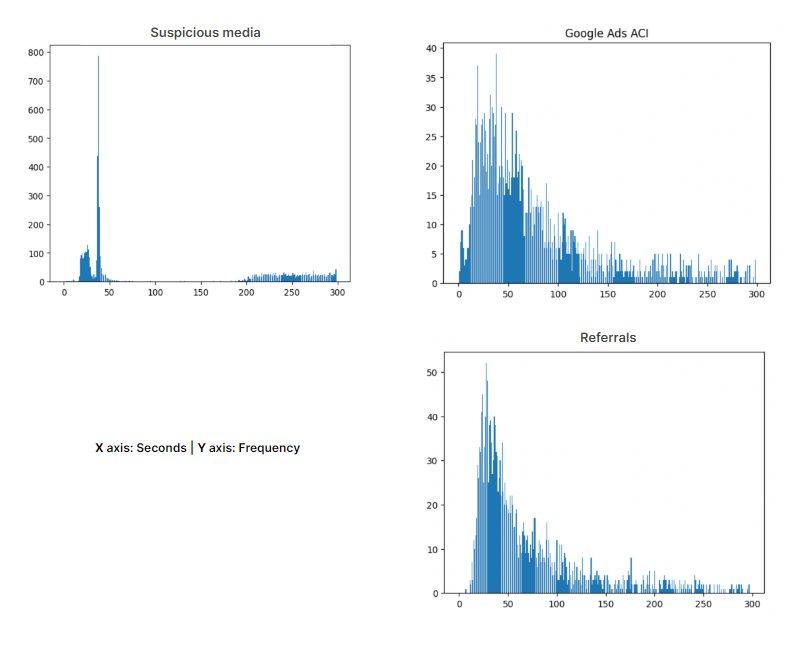 There is a huge difference between the pattern Google & Referrals follow and the suspicious media. Google & Referrals see installs increase strongly after 20s, and then they start slowly decreasing after 45-50s. In contrast, the suspicious media shows a sharp spike after 35s with an extremely high amount of installs in a very short lapse of time. Then, there is a strong fall after 40s, with no installs at all between 50 and 200 seconds.
There is a huge difference between the pattern Google & Referrals follow and the suspicious media. Google & Referrals see installs increase strongly after 20s, and then they start slowly decreasing after 45-50s. In contrast, the suspicious media shows a sharp spike after 35s with an extremely high amount of installs in a very short lapse of time. Then, there is a strong fall after 40s, with no installs at all between 50 and 200 seconds.
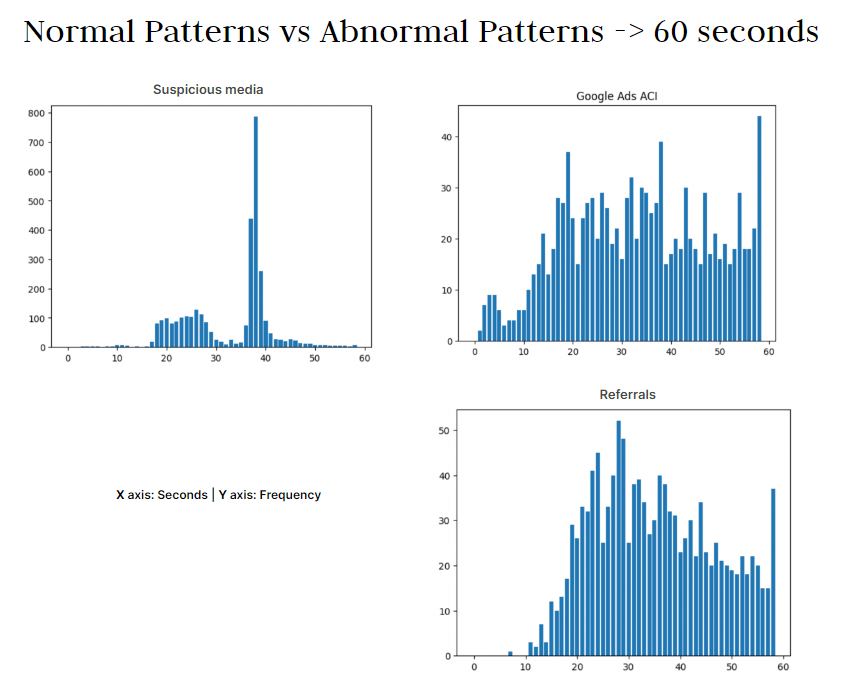
3 & 4. CTR > 1 & extremely low CPC/CPAs
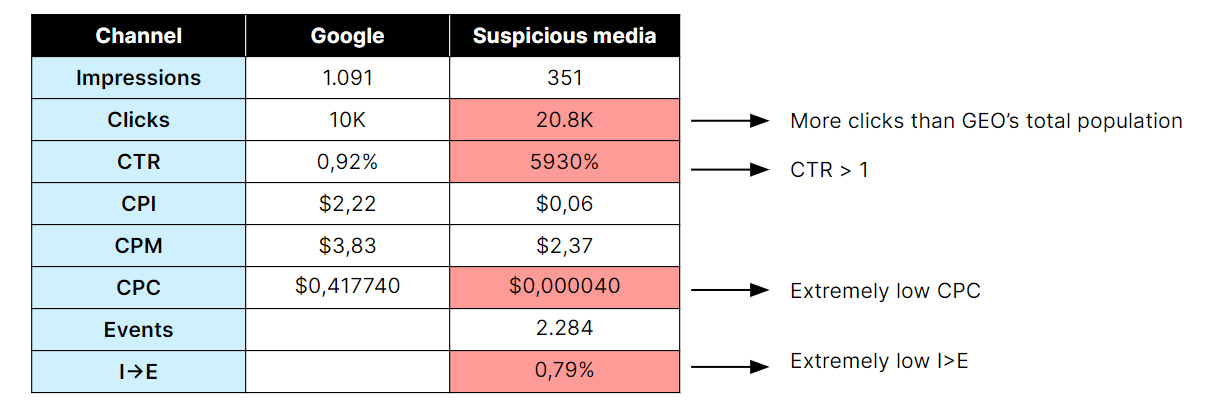 A couple of dubious KPIs: when comparing Google to suspicious medias, you’ll stumble upon very unreasonable metrics. It begs the question: “How could we be getting more clicks than the entire population of the country we’re targeting?”
A couple of dubious KPIs: when comparing Google to suspicious medias, you’ll stumble upon very unreasonable metrics. It begs the question: “How could we be getting more clicks than the entire population of the country we’re targeting?”
5. Huge discrepancies between Media and Measurement Partner

To conclude, we’ve also seen an enormous discrepancy between the amount of installs reported by Google and the client’s Mobile Measurement Partner.
If the industry discrepancy benchmark is 20%, you might be asking yourself: “what’s going on with the rest of it?” Google is a clear victim here, another media is wrongfully attributing themselves to Google’s installs.
Clear red flags, right? Which were the next steps?
- Request more information to the suspicious media regarding site IDs and total impressions.
- Our suggestion: do an Incrementality Test (turn off suspicious medias and evaluate Blended CPA)
Start thinking on cost-efficient solutions
Most tech solutions will drown you with complex algorithms and paid subscriptions which won’t address transparency issues. In fact, they’re likely part of the problem, as their best interest is to keep the show going to ensure their revenue streams.
As a marketer, you might wonder: “Another tool? How can I justify this, especially when I’m already using a martech stack like MMP, CDP, Google Analytics and more?
So, what’s the right strategy?
Start with a one-time audit. This will allow you to make an informed decision. Avoid locking yourself into long-term contracts or implementing more technologies.
Why? You won’t take 2 months on integration and a whole year to see results. On top of that, you won’t find yourself explaining to the CFO or CEO about yet another tool’s expense or detailing to your tech team how it will be implemented.
Our one and only advice
Consider the motivations and incentives of every party involved. Determine if being truthful or maintaining the status quo benefits them more.
Remember, fraud thrives when we turn a blind eye or remain silent. Let’s push our companies forward and seek real, transparent results!
An Unbiased Testimonial by Matías Carrera:
My first thought was, I need strong force to hit this goal. I had been a very experienced and resourceful marketer (mostly due to a big curiosty).
In Lemon Cash, I faced a big challenge: growing from 37K users to 1.2 million in less than six months. I realized I needed substantial force to hit this goal. Fortunately, I had been a very experienced and resourceful marketer (mostly due to a big curiosity). During this time I tried almost every existing source on the Internet.
We ran all sorts of medias you could imagine:
- Incentivized and non-incentivized traffic.
- Gaming
- SDK’s
- Ad Networks
- DSPs (Jampp, Liftoff, Criteo, DV360)
- Social (Tiktok, Twitter, Facebook, Instagram)
- Direct Agencies without any transparency.
Were we exposed to fraud?
Yes. Fraud is a business within our industry that has been around as long as the internet itself. It has always been there. One might think that fraud is easy to detect and that the people involved in it are informal or “amateur”. However, there are companies committing fraud with more technical capability than many private companies combined. That is, hacking, phishing, and a mix of creativity with automation.
Let me illustrate with a couple of examples:
- We had a source that created fake contests where if you performed a certain action in our app, they “donated food to NGOs.
- We also had a source which tried to bypass KYC with fake IDs.
So fraud is not just about stealing attributions or creating fake users; we also see cases where real users are deceived into taking actions based on false promises.
The ability to attempt to obtain fake events or steal attributions from SEO/ASO or other sources is increasing. Fortunately, in our case, we were able to detect it quickly, removing all fraudulent events from the databases and not paying for any of this activity. But in such a complex industry, with multi-touch attribution systems becoming increasingly challenging to develop, one must be very cautious.
What have we learned?
- The vast majority come from sources that don’t show their behind-the-scenes or don’t provide transparency on media, ads, placements, and site IDs. For me, transparency, control, and the proactivity of having quality monitoring indicators is something that any provider or internal team should have in place to protect the brand and, above all, the users.
- There are no magic solutions. One can propose combinations of tactics, campaigns (target and retarget), and more performance-based creatives, but it all boils down to being empathetic with the consumer, understanding their genuine pain point, and presenting a value proposition at the right time that addresses this, balanced by market size according to supply and demand. To grow, one can choose fast, cheap, or quality, but only two out of those three (at least in the vast majority of markets). In our case, since it was a new, rapidly growing, and massive market, we were able to find a middle ground. Yet, we still fell victim to fraud, even though we detected it quickly.
 Matias Carrera
Matias Carrera
VP of Growth & Marketing, Appgrade
If you’d like to know more about my experience or discuss fraud, let’s connect on LinkedIn
In the case you are suspicious that any of your paid media partners might be incurring in fraud, or you are pursuing a fraud prevention practice within your marketing team, feel free to reach out.


